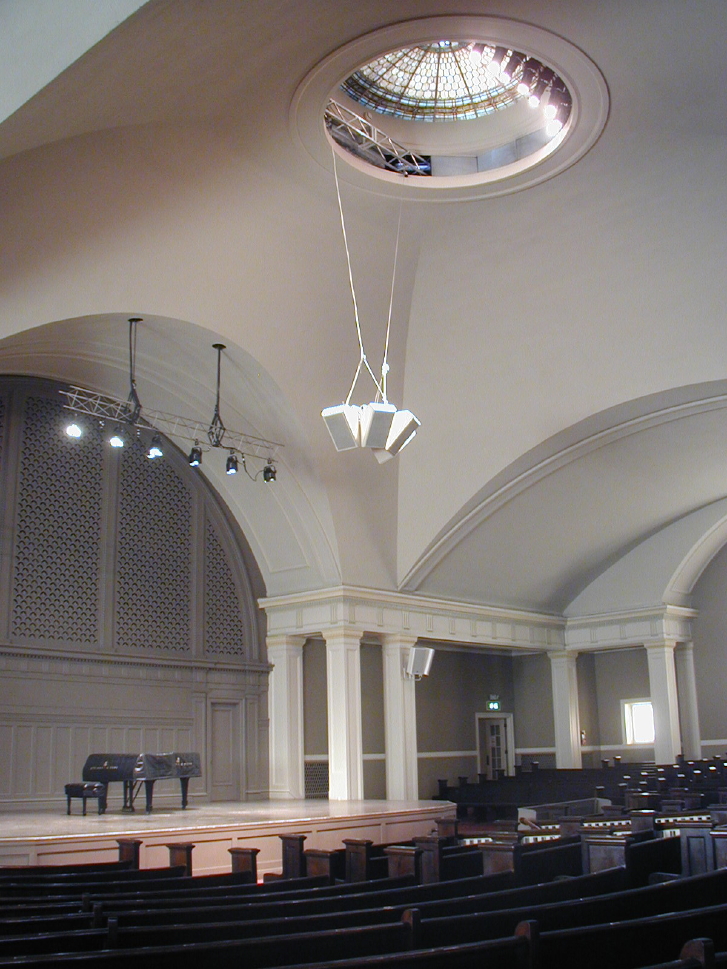Town Hall, Seattle, WA
Town Hall is Seattle’s community culture center located in the historic First Hill neighborhood, on the edge of downtown. Town Hall showcases the community’s cultural energy with diverse music, arts and humanities, civic discourse, and world culture programming. Housed in an historic Roman-revival-style building, Town Hall opened in March 1999.
Local, national and international programs and performances are scheduled year-round in the Great Hall and downstairs at Town Hall whose name recalls town-meeting democracy and is emphasized by the intimate, curved, amphitheater-style seating of the Great Hall.
A Little History
The Fourth Church of Christ, Scientist built this edifice in two stages, 1916-1922. It was built at the peak of the Christian Science movement when the church could afford generous spaces and fine finishes. The congregation was the sole and continuous occupant of the building until it was sold to Town Hall in 1998.
The architect for the church was George Foote Dunham of Portland, whose one other building in Seattle is the Christian Science Church on Fraternity Row in the University District. Dunham used a popular style for Christian Science churches, namely Roman Revival. Like most Christian Science Churches, this one is built to resemble a public building with no religious symbolism inside or out. The building has a large portico with six two-story columns, a central dome with oculus, large art glass windows, and elaborate window treatment with pilasters and a balcony. All four sides of the building are clad in terra cotta, which reflects light well in winter and glows after rain.
Town Hall has several remarkable features inside. A small stage is located in the ground floor. This was the original rostrum for the earliest services. In the Lobby, the art-glass, Tiffany-style lighting fixtures are all still working. Curved wooden pews with fitted backs grace the Great Hall, formerly the sanctuary. The vaulted ceiling and the central dome, together with the thick masonry walls and the dispersion of sound from all the ornamentation, produce warm, full, “live” musical acoustics of the type rarely created today.
240 Degrees of Sound
Town Hall chose PNTA (formerly known as Pacific Northwest Theatre Associates, Inc.) to do the job because of the complexity and ability to supply the particular speakers specified. One of the values PNTA offers its customers is the depth and variety of talent and knowledge among the staff which were taken advantage of in the installation of the new speaker cluster and the re-design of the lighting system. Town Hall provided some fun challenges for PNTA’s staff. The job specs included installation of a Bag End Sapphire speaker cluster to provide 240 degrees of sound coverage in the main auditorium.
The first step was to create a structure that would complement the architecture of the building while providing a means to hang the cluster over the center of the hall. PNTA’s engineer Silas Morse designed a box truss, anchored in the superstructure, to span the oculus and provide a point from which to hang the speakers. PNTA’s design staff specified a bracket that arrays all four Sapphire enclosures and a flying system that offers infinitely adjustable tilt angle. After installing the truss and hanging the speakers, PNTA’s crew also installed a QSC amplifier and speaker cable.
In a companion project, the Production Manager of PNTA’s Event Services department, Dave Vaught, designed, installed and focused the fixtures for a new lighting system. The challenge presented by the space is that the only central projection position is the oculus, and the new speaker cluster blocked most of that position.
In the first phase of the job, Dave re-arranged the rigging in the oculus to allow lighting instruments to shoot around the speaker cluster, restoring the previously-existing wash of light on the stage. In the second phase, he established positions to hang four more instruments for side fill. After that, he and his crew installed ETC Source Four fixtures and two NSI DDS6000+ dimmers. The side fill is an improvement of the lighting system, and the dimmers allow for possible future expansion.
Eight months of planning for this project culminated in two days of installation and resulted in new systems that will enhance the experience and enjoyment of audiences who come to Town Hall for concerts, lectures and other programs.
The neighborhood
Town Hall is located in a rich historic neighborhood. Numerous old churches, apartment buildings, hotels, social clubs, and early hospital buildings bespeak the time around the turn of the century when the city was expanding up the hill (in part to get some safe distance from downtown after the disastrous fire of 1889). This promontory overlooking downtown and Elliott Bay began as a neighborhood of prominent families who built fine mansions (four of which remain today). Soon, however, First Hill became richly various in its population. First Hill is a reviving urban village, with thousands of jobs, stately apartment buildings, fine views, nearby colleges, and a growing cultural base. Town Hall is recognized in the First Hill neighborhood as an essential part of this revival.

